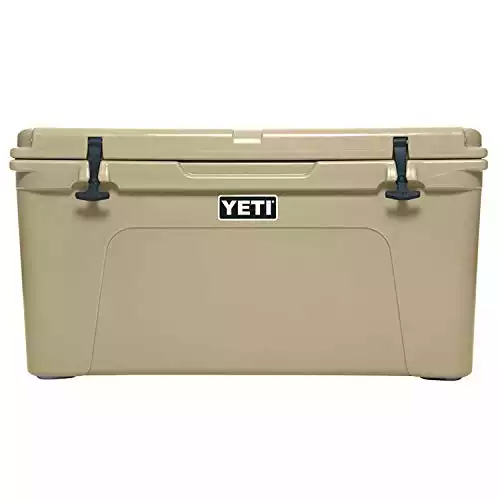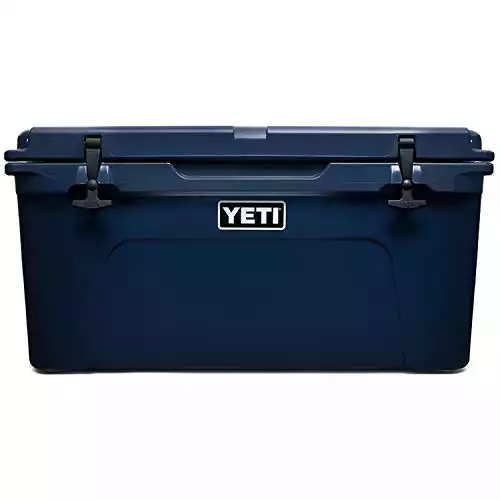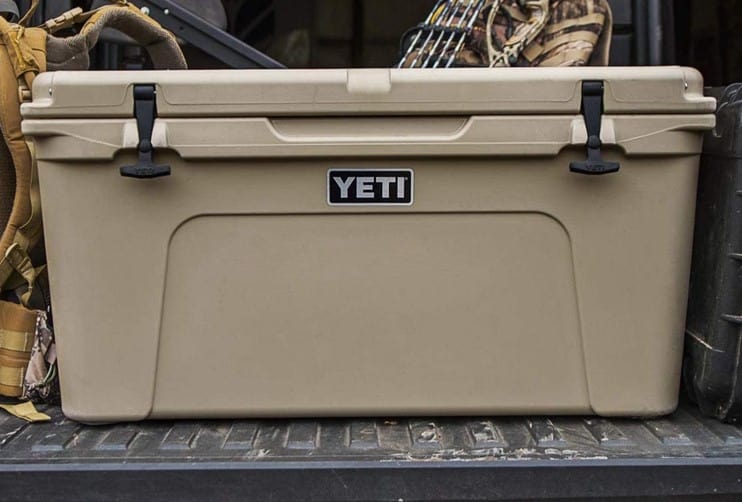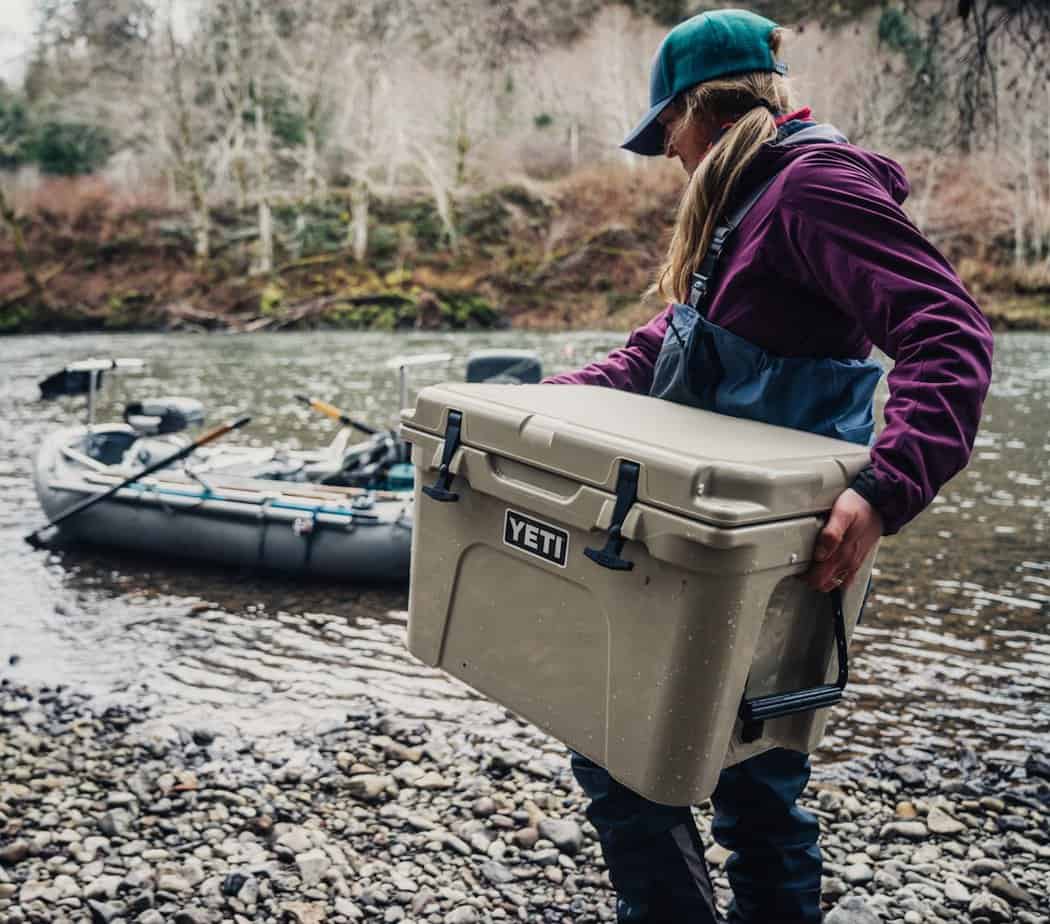Have you been hearing a lot about Yeti Tundra coolers lately?
Well, that’s because Yeti coolers are ruling the market. And, Yeti Tundra 65 and 75 are currently two best-selling hard coolers on the market. They are sturdy and sleek and you’ll love them.
So, if you’re looking for a durable, medium, or large-sized cooler in the Yeti Tundra line, you may want to consider Yeti Tundra 65 and 75. Several readers requested for Yeti Tundra 65 vs 75 comparison, and we’ve finally put a piece together to help you make an informed purchase.
Both Yeti Tundra 65 and 75 are made for the wild. Thanks to the thick insulation and rotomolded construction, the Yeti coolers are suitable for camping, kayaking, fishing, hunting, and many other outdoor activities.
In this comparison, we’ll review both products in detail and list their main differences. We’ll also discuss their features, pros and cons, and general specifications. Our experts tested both products hands-on over a period of 60 days before bringing the results to you.
Bottom Line Up Front Summary: Unless you have specific weight or size restrictions that you are trying to hit, the added capacity of the Yeti Tundra 75 is the safer bet for just 5 extra pounds of weight.
Table of Contents
Main Differences between Yeti Tundra 65 vs 75
- WhileYeti Tundra 65 weighs almost 29 pounds when empty, Yeti Tundra 75 weighs almost 34 pounds when it’s not filled.
- In terms of dimensions, both inside and outside dimensions of Yeti Tundra 75 are greater than those of Yeti Tundra 65.
- On the one hand, Yeti Tundra 65 can store 42 cans of beer and 50 pounds of ice, and on the other hand, Yeti Tundra 75 can store 57 cans of beer and 70 pounds of ice in a 2:1 ice ratio.
The Tundra 75 Cooler isn't even the biggest cooler that Yeti makes, but you'll be hard-pressed to find a situation in which 75L of soda-chilling, meat-cooling, ice-saving capacity isn't enough.
How to Find the Best Cooler on the Market?
Choosing the right hard cooler for your outdoor adventure can be a daunting task. Let’s look at some important factors you should consider while buying a cooler.
Hard Cooler or Soft Cooler?
First things first, it’s important to identify if you want a hard cooler or a soft cooler. Hard coolers are suitable for heavy-duty usage where durability and sturdiness play key roles. They typically have greater capacities than soft coolers.
Hard coolers also retain ice for longer periods. Soft coolers are suitable for general usage and are typically more stylish than hard coolers.
Normally Manufactured Cooler or Rotomolded Cooler?
Rotomolded coolers are premium products in the cooler industry. The plastic is beautifully molded to form a single piece without any faults or seams: the result – better ice insulation and retention.
Rotomolded coolers are stronger and more durable. They are also more expensive than the normally manufactured coolers. However, if you’re looking for a cheaper cooler, you may want to consider a normally molded cooler.
What’s the Purpose of Buying the Cooler?
Will you be using the cooler for fishing, hunting, or simply storing your beer cans? If you’re planning to use it for fishing, you may want a cooler that’s fitted with a fishing scale.
And. if you’re planning to use it for storing your beer cans and ice, you may want a cooler with a large storage capacity. So, the purpose of buying a cooler can significantly impact your purchase.
What About the Cooler Design?
There are several aspects of a cooler’s design. These include:
- Construction
- Materials used
- The technology behind the design
- Durability
- Quality of the cooler
And, all these factors matter a lot when it comes to the design of a cooler. On the one hand, you’ll find simple cooling boxes with limited insulation, and on the other hand, you’ll find complex designs with premium insulation layers and technologies.
What Features Are You Looking For?
Coolers are no more simple cooling boxes. They are now properly designed equipment that come with a plethora of interesting accessories and features that make them useful. Some features that the coolers should have include:
- A drain plug
- Handles
- Latches
- Fish rulers
- Baskets
- Compartments
- Bottle openers
- Additional pockets
What Cooler Size Will Suit Your Requirement?
Have a big crew and not enough cooler space to keep their drinks and food cold? Yeti's Tundra 65 Cooler will solve all your problems with a crowd-pleasing capacity and the ability to keep important stuff cold for hours on end.
Are you the only person who will use the cooler or are you looking for a cooler that can accommodate drinks and food for your entire group of friends and family members? Are you looking for a cooler than can store drinks and food for multiple days?
The sizes of coolers are typically measured in quarts. One quart is equivalent to almost 946 ml (almost less than a liter). On the market, you can find cooler sizes starting from a few quarts to over 500 quarts in capacity. However, the size of the cooler you want will depend upon your exact requirements and the time you’re planning to spend away from home.
While you may want a cooler with a greater capacity, it’s also important to consider the ease of use and mobility. If you’re planning to buy a large cooler, you can also purchase cooler wheels separately for easier usage.
What About the Warranty?
These days, many cooler brands are offering warranties with their products. Warranties can range anywhere between 1 year to lifetime warranties.
A warranty is a critical sign for buyers as it indicates that a brand is selling high-quality products and is ready to back the customers in the case of manufacturing issues.
Yeti Tundra 65 vs 75 – Comparison Based on General Specifications
|
Product Dimensions (Outside) |
30.5 x 17.5 x 16 inches |
33.2 x 18 x 18 inches |
|
Product Dimensions (Inside) |
23.2 x 11.2 x 10.5 |
25.6 x 12.8 x 10.7 inches |
|
Product Weight |
29 lbs. |
34 lbs. |
|
Model no. |
YT65T |
10075010000 |
|
Capacity |
42 cans of beer or 52 pounds of ice or 52 quarts |
57 cans of beer or 70 pounds of ice or 72 |
|
Available Colors |
Desert Tan, Ice Blue, Seafoam, White |
Desert Tan, White |
|
Fatwall Design |
Yes |
Yes |
|
Permafrost Insulation |
Yes |
Yes |
|
Type of Construction |
Rotomolded |
Rotomolded |
Yeti Tundra 65 vs 75 – A Detailed Comparison
Now that you have an idea about the basic physical differences between Yeti Tundra 65 and 75, let’s look at the detailed comparison between the two Yeti Tundra models to see which is better for your requirement.
Design and Style
When it comes to the construction and design of the coolers, you won’t notice any major differences as both Yeti 65and 75 have a sleek but rugged look.
Some interesting features that both models support are:
- A cold lock gasket – The coldlock gasket can be found around the boundary of the lid. It blocks out the heat and locks the cold inside.
- Doublehaul handles – The handles are made of polyester rope. They make it comfortable and convenient to carry the filled cooler.
- LipGrip handles – The LipGrip handles can be found underneath the lid and provide a strong grip if you’re lifting the cooler yourself.
- Slip-resistant feet – To make sure your cooler doesn’t slide here and there while you’re traveling, it comes with slip-resistant feet to hold the ice cooler in place.
- Tie-down slots – Using the tie-down slots, you can quickly mount the cooler on your kayak, truck bed, and so on.
- A never-breaking hinge arrangement – The hinge system comprises two hinge pins and a smart, interlocking design to prevent breakage of the hinge.
- A vortex drain system – From soggy french fries to ice-cold water, you can simply remove the leftovers inside the cooler by removing the drain plug that is designed for easy and quick draining. The drain plug is leakproof.
Capacity and Size
As mentioned in the Yeti Tundra 65 vs 75 tables above, Yeti Tundra 65 can easily hold 42 cans of beer and 52 pounds of ice whereas Yeti Tundra 75 can comfortably hold around 57 cans of beer and 70 pounds of ice in a 2:1 ice ratio.
So, if you’re planning a vacation with a large group of friends or your extended family, we recommend you buy Yeti Tundra 75 if you don’t want to run out of stock. After all, Yeti Tundra 75 can hold around 15 cans more than Yeti Tundra 65.
Weight
When empty, Yeti Tundra 65 weighs 29 pounds whereas Yeti Tundra 75 weighs 34 pounds. However, when completed or even partially filled, Yeti Tundra 75 can become heavy and difficult to carry. In terms of ease of carrying, you’ll find Yeti Tundra 65 more suitable to carry or transport.
All in all, Yeti Tundra 65 is lightweight. But, the difference between the weights of both models is not much and should not be a problem.
Construction and Durability
When it comes to construction, both Yeti Tundra 65 and 75 are built using the same construction process. They are bulky and rugged. Moreover, both coolers are made of up to 2-inch thick permafrost insulation and rotomolded construction.
You’ll be surprised to know that our experts tested the construction of Yeti Tundra 65 and 75 using chainsaws, and the results were shocking. Both rotomolded coolers passed the test. Our experts found it extremely difficult to penetrate the walls of the coolers. Nevertheless, the coolers were left destroyed at the end of the test.
All in all, Yeti Tundra 65 and 75 are made of the same materials and come with a strong built. The coolers can survive for years together.
Ice Retention
Many prospective buyers believe that Yeti Tundra 75 can store ice for longer durations than Yeti Tundra 65. However, the same is just a myth. The truth is that all Yeti coolers come with the same ice retention property. You can enhance the ice retention performance of the cooler by packing it nicely and reducing frequent opening and closing of the lid.
Other significant factors that can affect the ice retention performance are the outside temperature and weather conditions. After thorough testing, our experts have concluded that both Yeti Tundra 65 and 75 can comfortably provide 3-4 days of ice retention.
Nevertheless, you can push the ice retention period to up to 7 days with good quality ice packs, proper packing of the cooler, and so on.
Usage
If you’re planning to buy a cooler for your camping adventure, fishing trips, hunting sessions, and so on, we recommend you buy Yeti Tundra 65 as it is more compact and easy to carry.
It can keep your stuff cool for 4-5 days. However, if you’re planning elaborate vacations with a large bunch of friends or extended family, we recommend you go with Yeti Tundra 75.
The Tundra 75 Cooler isn't even the biggest cooler that Yeti makes, but you'll be hard-pressed to find a situation in which 75L of soda-chilling, meat-cooling, ice-saving capacity isn't enough.
Pros and Cons of Yeti Tundra 65
Pros |
Cons |
|
Durable and sturdy |
Very heavy when fully loaded |
|
Great insulation |
Expensive |
|
Anti-slip feet |
The rope handles are not very comfortable |
|
Anchorpoint tie-down slots |
No leash for the drain plug |
|
Rotomolded construction |
|
|
Freezer-quality gasket |
|
|
Double-handled |
|
|
Easy to use |
Pros and Cons of Yeti Tundra 75
Pros |
Cons |
|
Durable and robust |
Very heavy when fully loaded |
|
Permafrost insulation |
Expensive |
|
Anti-slip feet |
The rope handles are not very comfortable |
|
Anchorpoint tie-down slots |
No leash for the drain plug |
|
Rotomolded construction |
|
|
Freezer-quality gasket |
|
|
Double-handled |
|
|
Easy to use |
|
|
Greater capacity |
|
|
Designed to handle extremely low temperatures |
How We Tested Yeti Tundra 65 and 75 to Bring You the Results
Here’s a list of factors we took into account for testing Yeti Tundra 65 and 75:
Technical Specifications
We carefully inspected the technical specifications of both coolers and compared them against many other hard coolers on the market. We also checked if the coolers were rotomolded or normally molded. We also tried to find answers to the following questions:
- What are the capacities of the coolers?
- What type of lid gasket do they have?
- What kind of handles and latches do the coolers have?
Materials Used
We tested the materials used to build the coolers and ensured they are environmentally friendly. We also checked the materials for durability and quality. We don’t want you to buy coolers that give up in a few months.
Construction and Design
We want you to buy a cooler that works well and looks good too. Therefore, we tested the construction and design of Yeti Tundra 65 and 75 by soliciting opinions from existing customers. We also ensured we tested each and every feature of both coolers.
Quality of Insulation
The insulation quality and ice retention go hand in hand. Therefore, we tested both Yeti Tundra 65 and 75 by storing drinks, food, and ice for almost a week.
Comparison With Other Similar Coolers on the Market
How do other similar coolers related to the Yeti Tundra coolers? Are the Yeti Tundra coolers mere copies or serious contenders? These are some factors on which we based our testing and research.
Frequently Asked Questions About Yeti Tundra 65 vs 75
Question: Can we use dry ice with Yeti Tundra 65 and 75?
Answer: Yes, you can use dry ice with both products.
Question: How many cans will Yeti Tundra 65 hold?
Answer: Yeti Tundra 65 can hold up to 42 cans, whereas Yeti Tundra 75 can easily hold up to 57 cans.
Question: Do Yeti Tundra 65 and Yeti Tundra 75 come with dry goods racks?
Answer: Yes, both Yeti Tundra 65 and 75 come with a dry goods rack each.
Question: Why are Yeti coolers expensive?
Answer: Yeti coolers are expensive because customers are willing to pay a high price for the brand. Moreover, since most of the coolers sold by Yeti are rotomolded, they’re more expensive than other normally manufactured coolers on the market.
Yeti Tundra 65 vs 75 – The Verdict
When it comes to choosing the best cooler between Yeti Tundra 65 and 75, everything trickles down to personal preference and requirements.
If you’re planning a fishing or hunting adventure, you may want to carry Yeti Tundra 65 as it is compact and lightweight when not fully loaded.
Whereas, if you’re planning a week or 10-day trip with friends or family, you may want to carry Yeti Tundra 75 as it comes with a larger capacity. It can store more food, drinks, and ice than Yeti Tundra 65. Nevertheless, ice retention will be the same with both models.
Just because Yeti Tundra 75 is larger in capacity and size than Yeti Tundra 65, it doesn’t mean it’ll retain ice longer than Yeti Tundra 65.
Bottom Line Summary: Unless you have specific weight or size restrictions that you are trying to hit, the added capacity of the Yeti Tundra 75 is the safer bet.
Have a big crew and not enough cooler space to keep their drinks and food cold? Yeti's Tundra 65 Cooler will solve all your problems with a crowd-pleasing capacity and the ability to keep important stuff cold for hours on end.
We hope you found the comparison helpful. If you have any more questions regarding any of the products, feel free to post them in the comment section below. We promise our experts won’t close this chapter until they answer all your questions!
Further Reading on Coolers:
- Yeti Tundra 45 vs 35
- Yeti Tundra vs Igloo Sportsman Cooler Comparison
- Yeti vs Grizly Cooler Comparison
- Yeti vs Orca Cooler Comparison
- Yeti vs Otterbox Cooler Comparison

David is a strong advocate of outdoor-related activities and has many years of experience backpacking and hiking around the world, including the Italian and Austrian Alps in Europe as well as central and southern Asia.
Locally, he has also led many groups cycling through Vermont, Nova Scotia, and Wisconsin. David constantly uses and tests the latest gear for the outdoors, which in turn allows him to help others make more informed buying decisions. He’s excited to share more of his knowledge and to see others enjoying the great outdoors more because of his advice and recommendations.









